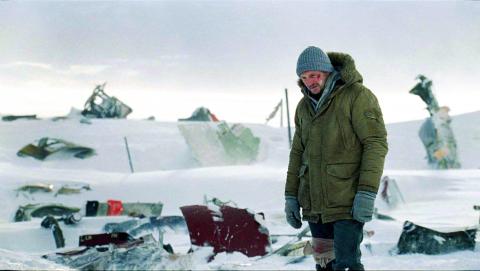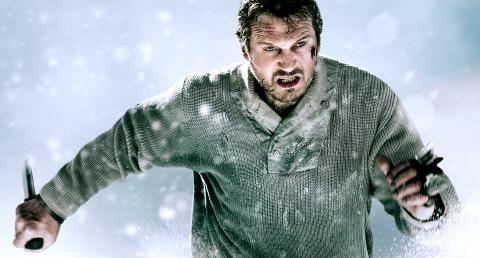The Grey continues what has become a welcome annual movie tradition. For the past three years, just when the Oscar awardees you’ve missed are trying to dazzle and guilt-trip you with visions of importance, a lean and angry Liam Neeson shows up at the multiplex, out for righteous payback or at least the paycheck that no one would dare begrudge him. Buy a ticket, punk!
Having paid his quality biopic dues as Oskar Schindler, Michael Collins and Alfred Kinsey, Neeson has, at least for now, turned to the rougher and perhaps more lucrative work of action heroism. It takes nothing away from his earlier achievements to note that he’s really good at it. He conveys a ferocious and absolute seriousness even when the going gets silly, and he finds the soul in each new angry-everyman cipher he is asked to play.
In Taken and Unknown, he explored the genre in its fast-moving, super-twisty cosmopolitan thriller mode. Those were glib entertainments improved by their star’s natural gravity. The Grey, directed by Joe Carnahan from a script he wrote with Ian Mackenzie Jeffers (based on Jeffers’s story Ghost Walker), is something else entirely: a stripped-down, elemental tale of survival in brutal circumstances, as blunt and effective — and also, at times, as lyrical — as a tale by Jack London or Ernest Hemingway. It’s a fine, tough little movie, technically assured and brutally efficient, with a simple story that ventures into some profound existential territory without making a big fuss about it.

Photo Courtesy of Liddell Entertainment
The geographical territory the film stakes out is a bleak, frozen and harshly beautiful corner of Alaska, where Neeson and a bunch of other excellent actors are stranded after surviving a plane crash. Neeson’s character, Ottway, is part of a tribe of brawlers, drinkers and lost souls who work in the Arctic oil fields. His job is to roam the tundra with a high-powered rifle, “a salaried killer for a petroleum company,” picking off the predatory animals that menace the other workers. Ottway doesn’t say much, and we know nothing of his background other than that he once had a wife (played in flashbacks by Anne Openshaw). His melancholy voice-over narration early on is a letter to her.
The sentiments he expresses there hint at a core of tenderness behind his gruff, hangdog demeanor. It is clear that he is a man of violence with a keen, ruthless survival instinct, but also that he harbors deep reservoirs of sorrow and compassion. Shortly after the crash, tending to a badly injured passenger who clearly won’t make it, he eases the man’s passing with breathtaking gentleness.
That is not a phrase you would ordinarily associate with Carnahan, whose directing resume includes exquisite delicacies like Smokin’ Aces and The A-Team. The sadistic, macho bluster of those movies seemed, at best, a gesture of mock rebellion, something to make football fans and beer drinkers feel like warriors. Such extreme, noisy fantasies of embattled pseudo-manhood might work as parody if they showed any genuine wit.

Photo Courtesy of Liddell Entertainment
But The Grey unfolds in a mood of grim earnestness and is grounded in an idea of masculinity under duress that is no less authentic for being thoroughly sentimental. The survivors are all guys, every one possessing his own special blend of insecurity, bravado, courage and stupidity. They are bundled up in parkas, their faces obscured by stubble, snow and blood, so their personalities emerge through action and interaction.
Some live, some die, and rather than divulge their fates, I’ll list the names of the hardy souls who trudge off into the woods with Ottway: Burke (Nonso Anozie), Henrick (Dallas Roberts), Talget (Dermot Mulroney) and Diaz (Frank Grillo). One is a cynical ex-con, another a God-fearing father, but Carnahan doesn’t overplay their differences or push the actors — all excellent — toward caricature. He respects their individuality and the specific life-or-death predicament each must face.
Pursued by wolves, the men start to replicate the pack behavior of their predators. At one point, just out of sight, they hear howls and yelps that Ottway explains are the sounds of the alpha putting down a challenge to its authority. A few minutes later he does the same thing, dealing with someone foolish enough to question his wisdom and instincts.
Not that Ottway is in control of the situation. It is hard, in this cozy, wired-up, GPS world, to imagine circumstances in which human beings would be so completely at the mercy of nature, but Carnahan constructs a persuasive picture of primal danger. The wolves (designed by Greg Nicotero and Howard Berger) are an unremittingly, unromantically hostile presence, in part because the world into which Ottway and the others have tumbled belongs so completely to them. Their imperative is to hunt, eat and finally destroy the intruders, and every other natural force, from gravity to the weather to blind chance, seems to be on their side.
Which means that much of The Grey is devoted to the practical details of problem-solving: building fires, improvising weapons, securing food, keeping watch. Such details are the building blocks of suspense and also the scaffolding for the big themes that hover in the wintry air.
Action movies, including Carnahan’s earlier films, often turn death into sport, numbing pain, fear and desolation with the visceral rush of violence. The Grey, meticulous in its choreography of fight and flight, and questionable in its depiction of wolf behavior, is notable for the thoughtfulness and sensitivity with which it addresses the thorny ethical and metaphysical matters of mortality. It takes death seriously, and partly as a consequence, every moment, every frame, feels alive.

In the March 9 edition of the Taipei Times a piece by Ninon Godefroy ran with the headine “The quiet, gentle rhythm of Taiwan.” It started with the line “Taiwan is a small, humble place. There is no Eiffel Tower, no pyramids — no singular attraction that draws the world’s attention.” I laughed out loud at that. This was out of no disrespect for the author or the piece, which made some interesting analogies and good points about how both Din Tai Fung’s and Taiwan Semiconductor Manufacturing Co’s (TSMC, 台積電) meticulous attention to detail and quality are not quite up to

April 21 to April 27 Hsieh Er’s (謝娥) political fortunes were rising fast after she got out of jail and joined the Chinese Nationalist Party (KMT) in December 1945. Not only did she hold key positions in various committees, she was elected the only woman on the Taipei City Council and headed to Nanjing in 1946 as the sole Taiwanese female representative to the National Constituent Assembly. With the support of first lady Soong May-ling (宋美齡), she started the Taipei Women’s Association and Taiwan Provincial Women’s Association, where she

Chinese Nationalist Party (KMT) Chairman Eric Chu (朱立倫) hatched a bold plan to charge forward and seize the initiative when he held a protest in front of the Taipei City Prosecutors’ Office. Though risky, because illegal, its success would help tackle at least six problems facing both himself and the KMT. What he did not see coming was Taipei Mayor Chiang Wan-an (將萬安) tripping him up out of the gate. In spite of Chu being the most consequential and successful KMT chairman since the early 2010s — arguably saving the party from financial ruin and restoring its electoral viability —

It is one of the more remarkable facts of Taiwan history that it was never occupied or claimed by any of the numerous kingdoms of southern China — Han or otherwise — that lay just across the water from it. None of their brilliant ministers ever discovered that Taiwan was a “core interest” of the state whose annexation was “inevitable.” As Paul Kua notes in an excellent monograph laying out how the Portuguese gave Taiwan the name “Formosa,” the first Europeans to express an interest in occupying Taiwan were the Spanish. Tonio Andrade in his seminal work, How Taiwan Became Chinese,